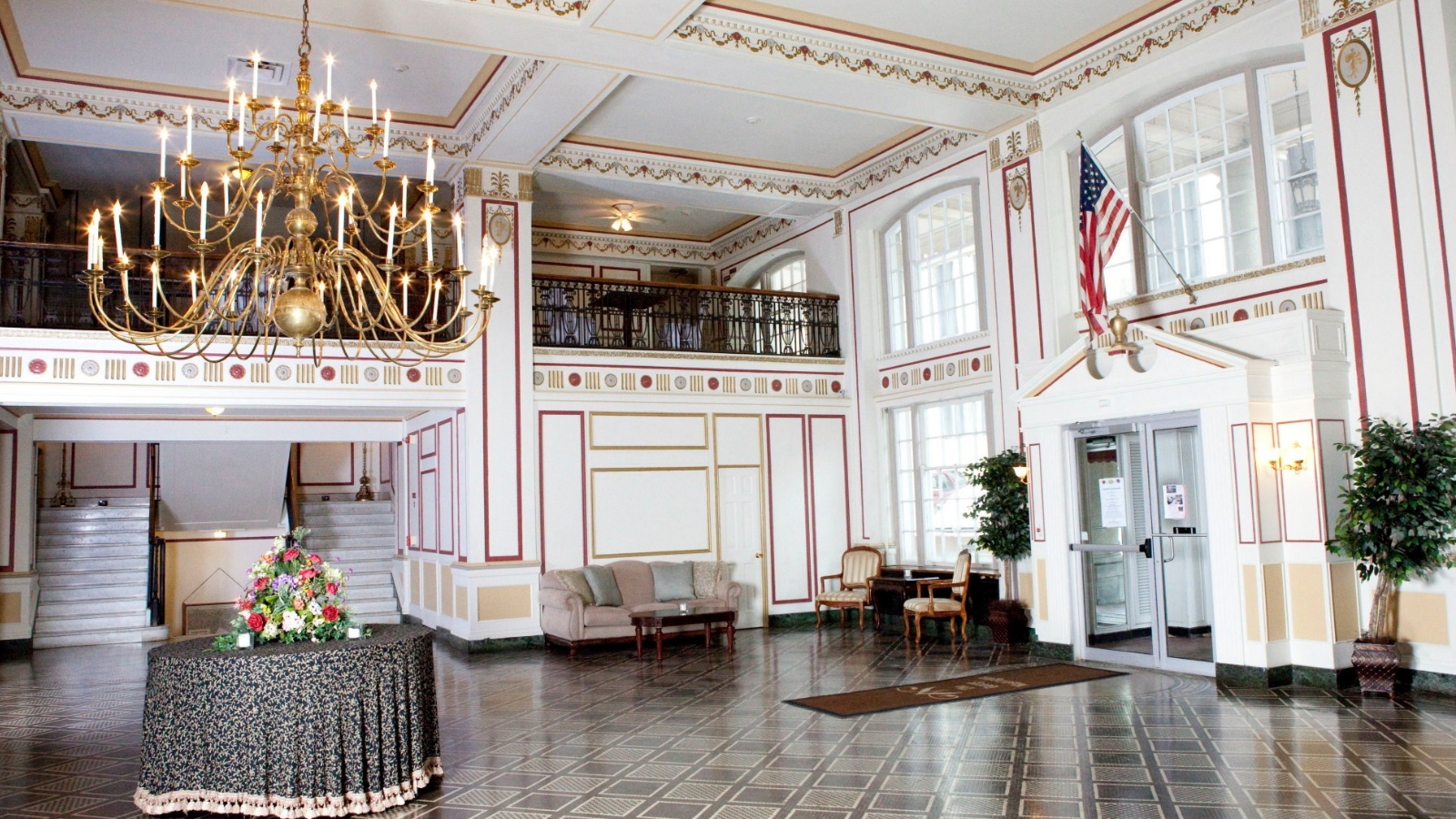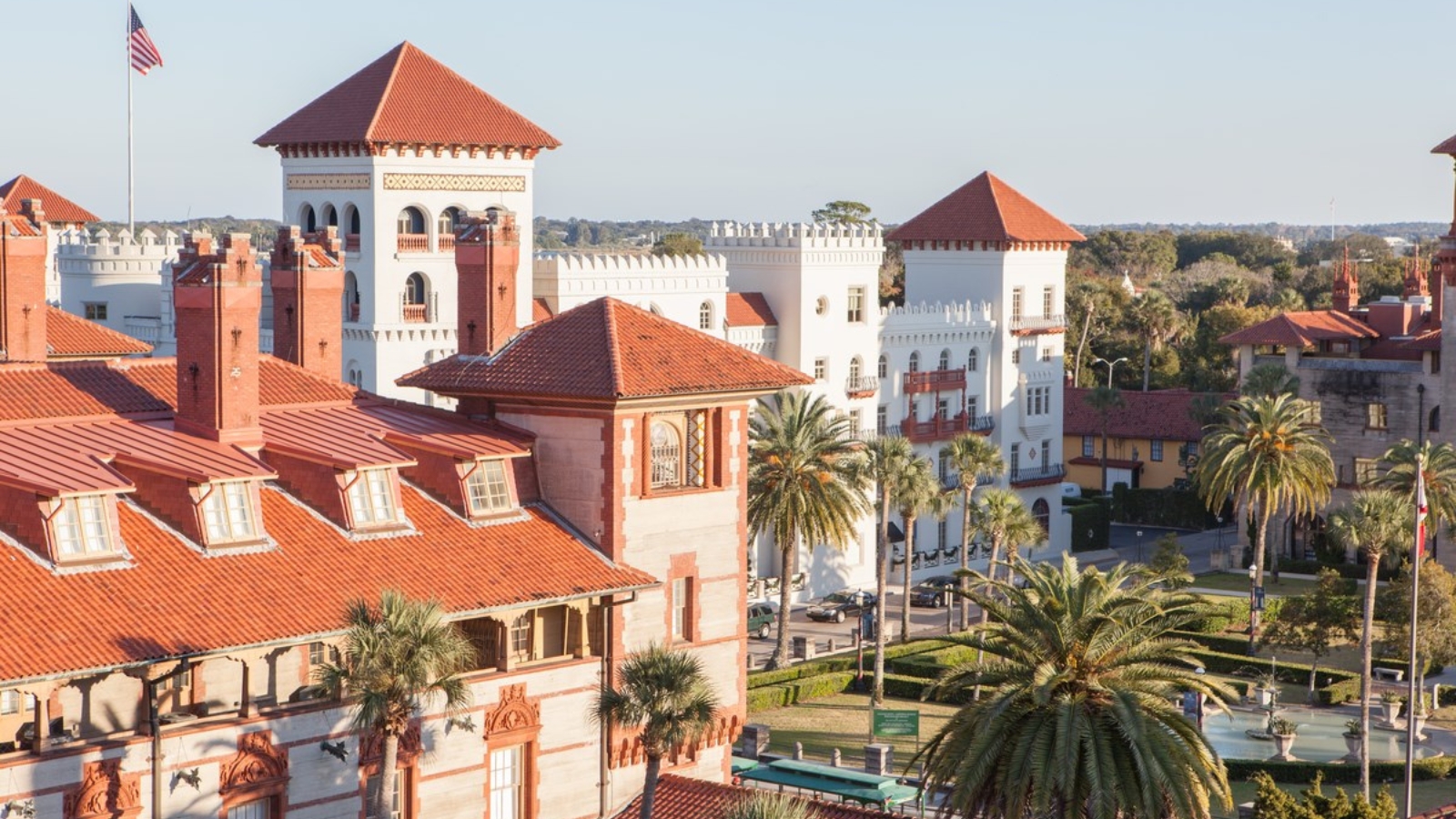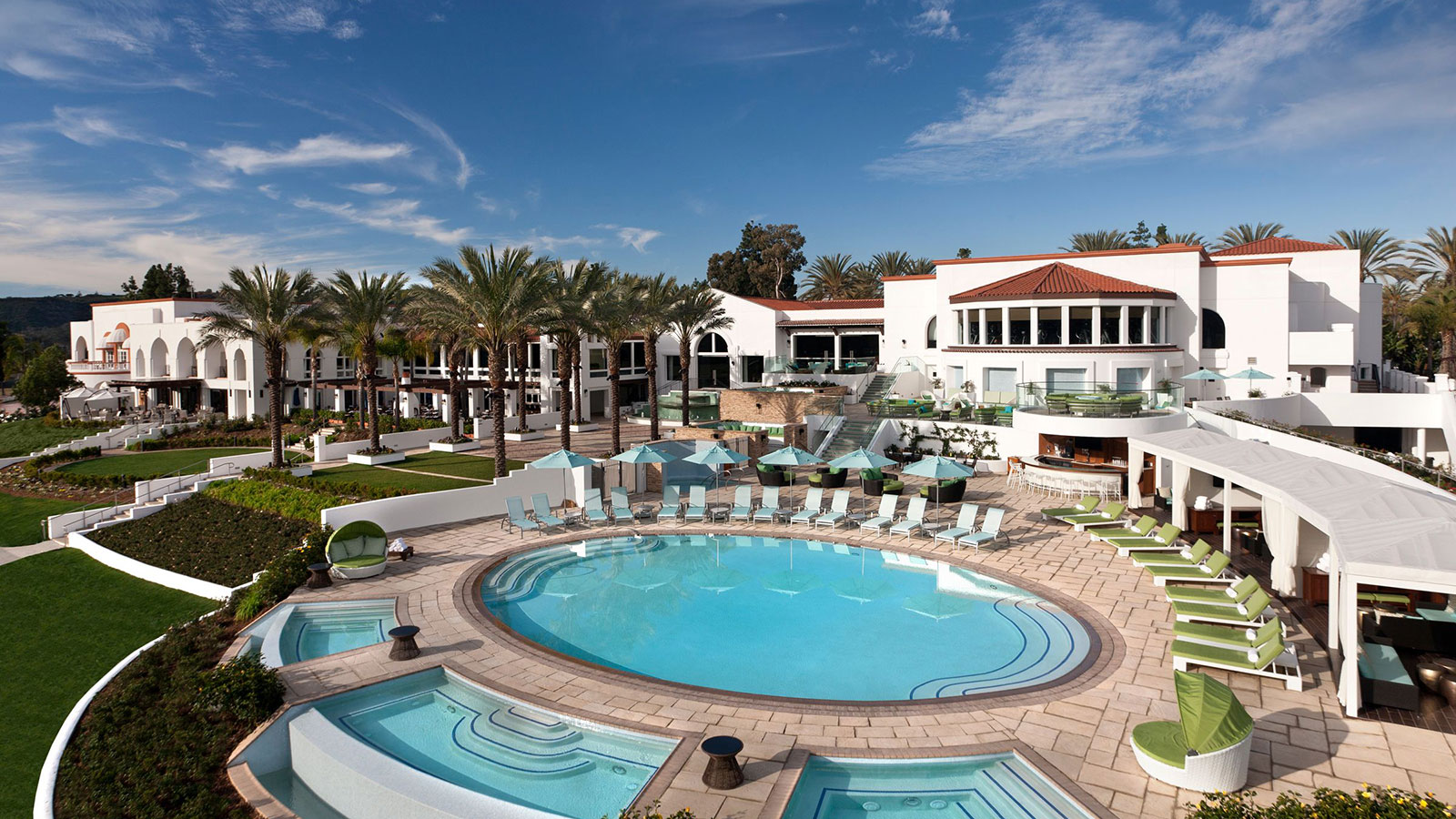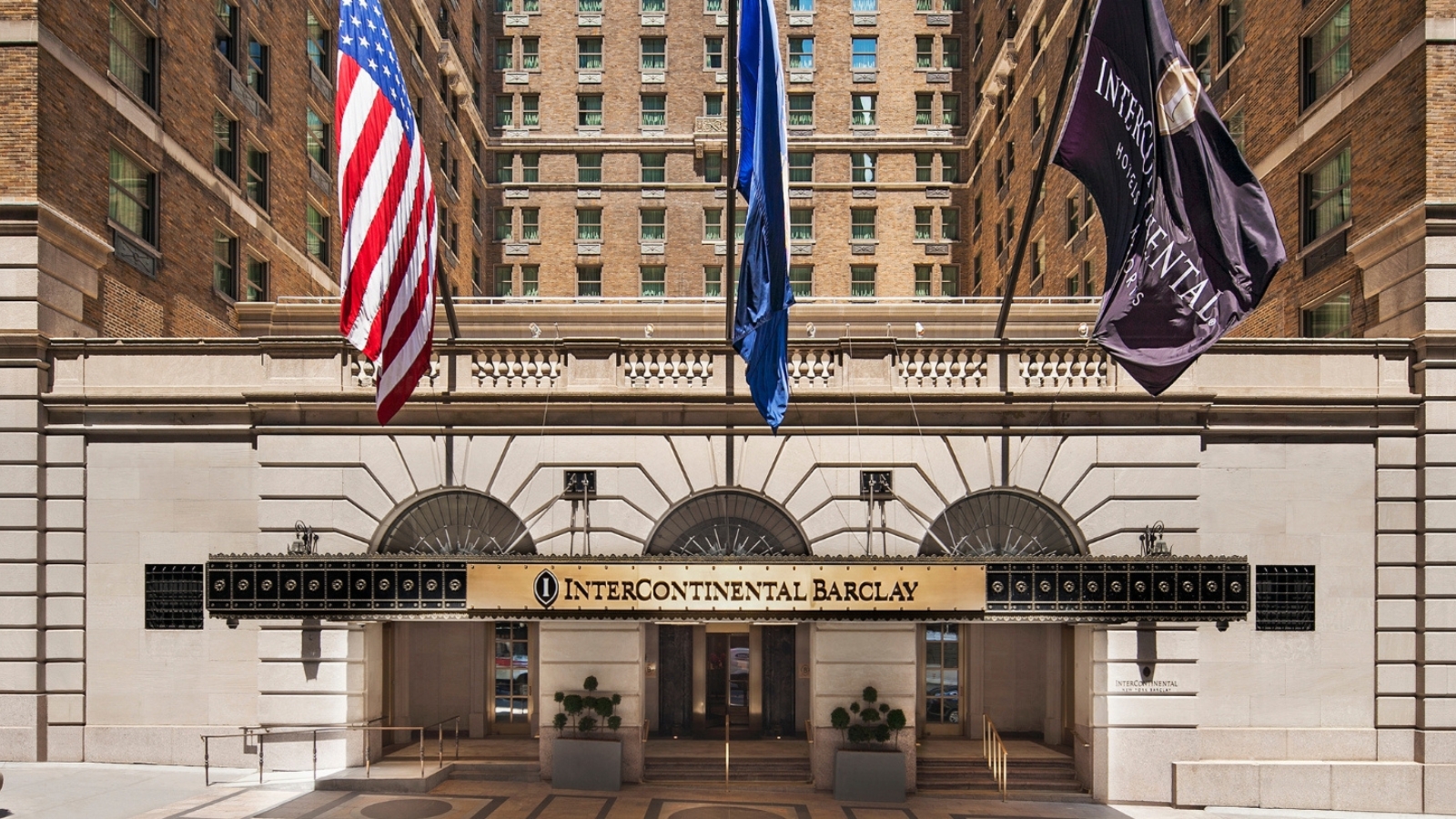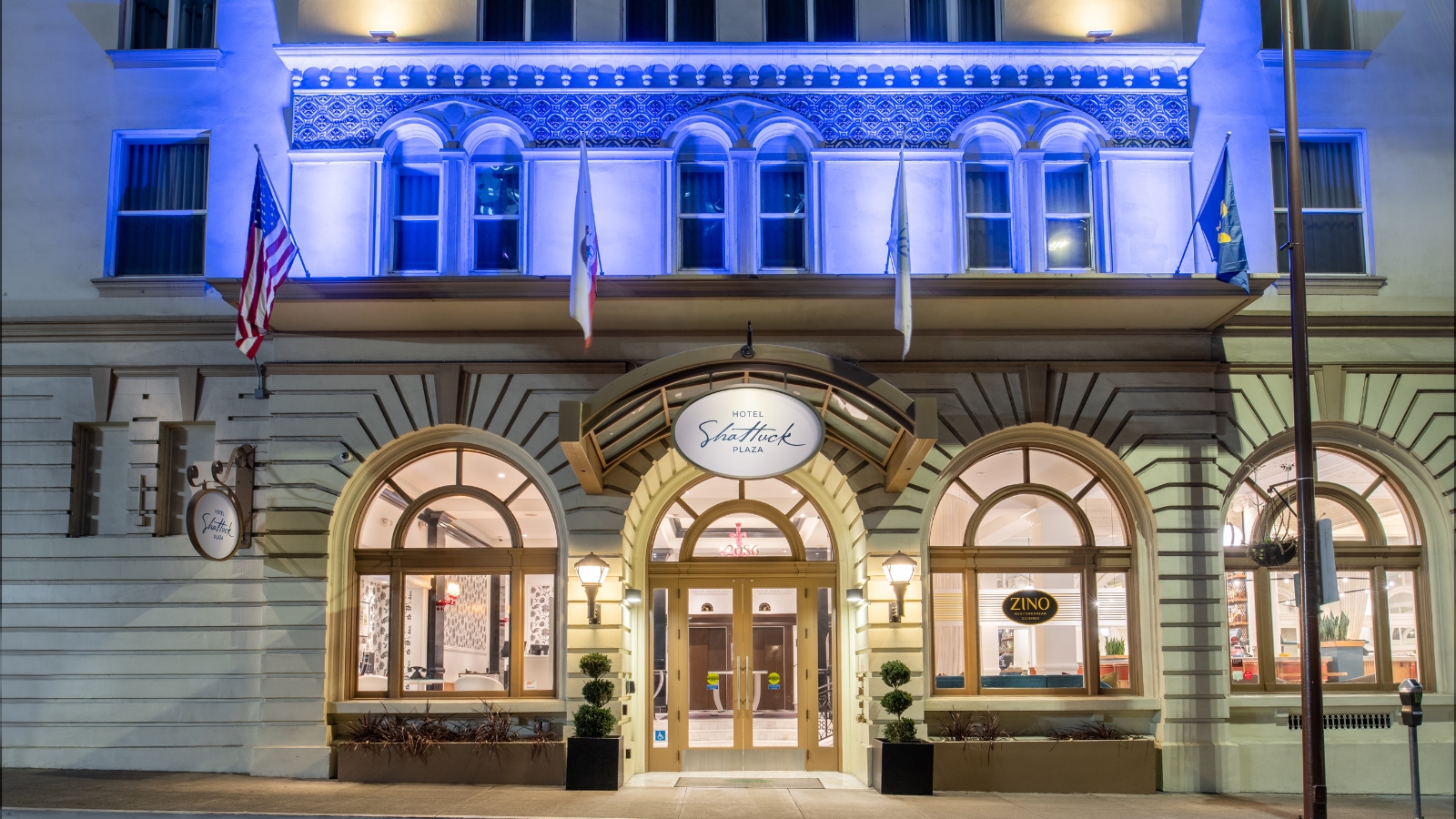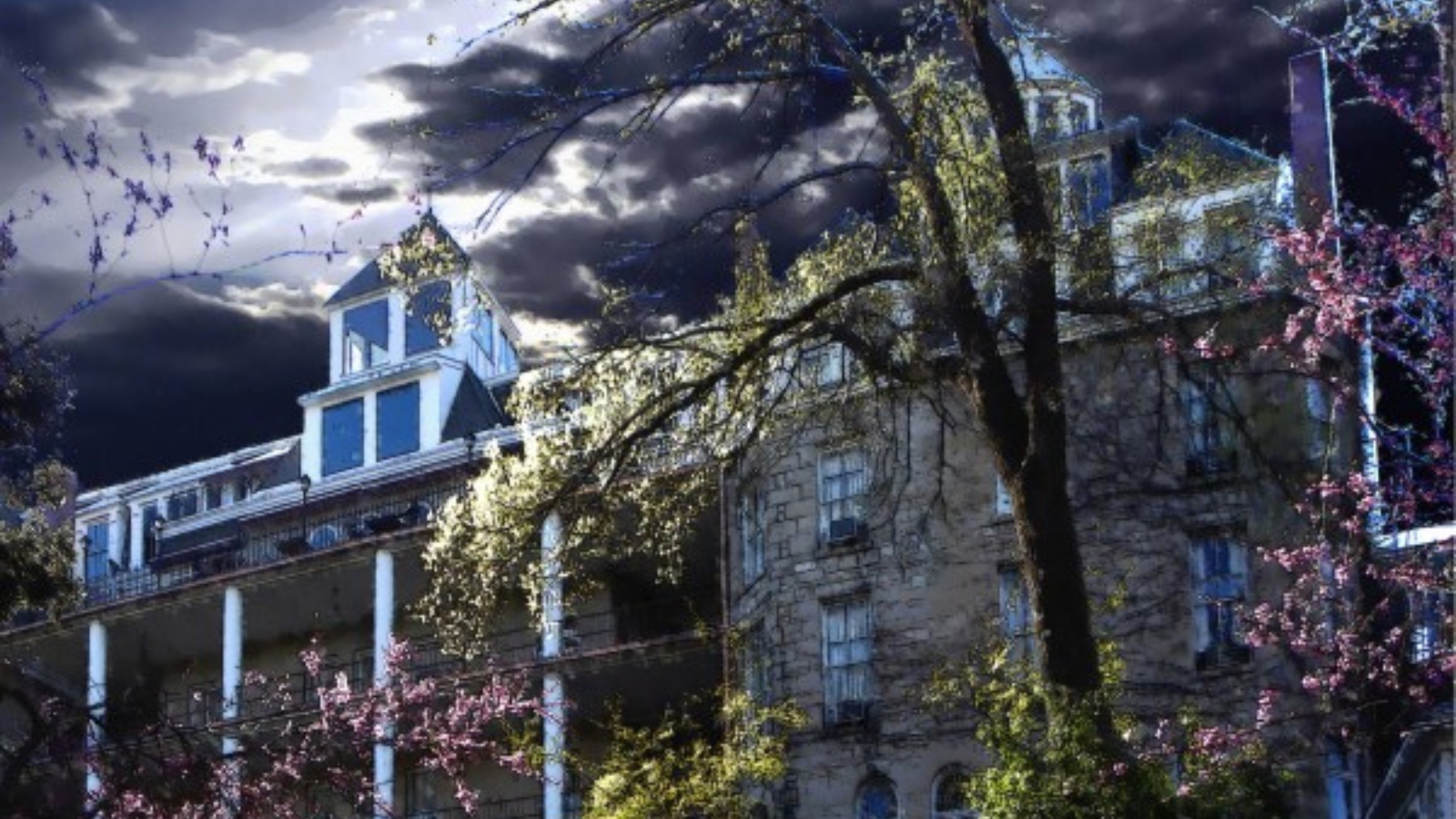Receive for Free - Discover & Explore eNewsletter monthly with advance notice of special offers, packages, and insider savings from 10% - 30% off Best Available Rates at selected hotels.
2021 Top 25 Historic Hotels Of America Most Magnificent Art Collections

Top 25 Historic Hotels of America Art Collections
Historic buildings are themselves works of art, but the historic buildings dating back over 300 years are not always the main event. Wander the halls of a 21c Museum Hotel by MGallery and marvel at the colorful penguins created by the Cracking Art Group. The Lancaster Arts Hotel in Pennsylvania connects local artists with first time art purchasers and is one of the Historic Hotels across the country that have combined elegant hospitality with museum quality art collections boasting furniture, paintings, sculpture, augmented reality, fountains and more.
Explore this list of the Top 25 Historic Hotels of America Art Collection for 2021 and plan your next trip to a museum you can sleep in.
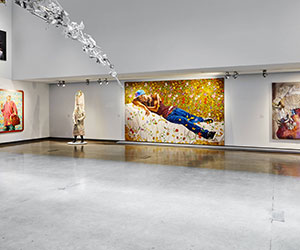 |
21c Museum Hotel Louisville (1800) Louisville, Kentucky Currently on view at 21c Museum Hotel Louisville by MGallery is Wim Botha: Still Life with Discontent. Co-curated with the North Carolina Museum of Art, this is the first US exhibition of work by the South African artist. The exhibit includes 51 works of sculpture, painting, works on paper, and a site-specific installation Truth or Dare: A Reality Show; a thematic group exhibition featuring painting, sculpture, photography, and video by 42 artists. Guests regularly bring friends to experience Text Rain by Camille Utterback & Romy Achituv, an interactive video projection installation offering guests the opportunity to do what seems magical—lift and play with falling letters that do not really exist. An event from Louisville history is explored by artist Anne Peabody, who created a physical record of her memory of the tornado that leveled much of the city on April 3, 1974. Peabody’s Wheel of Fortune consists of broken eggs, flashlights, dolls’ heads, turkey basters, and batteries made of wood as well as found objects made of glass that swirl together to form a massive funnel cloud in 21c Museum Hotel Louisville by MGallery’s Atrium Gallery. Virgil Marti’s Landscape Wallpaper explores relationships between art and decoration, landscape and the built environment. Art is indeed everywhere at 21c Museum Hotel Louisville by MGallery. Enter one of the elevators and guests find a seemingly infinite space, a feeling created by Ivan Navarro’s Untitled; light box installations from his Holeway series. Spend the night in Asleep in the Cyclone, a sculptural installation by Jonah Freeman and Justin Lowe that is also a functional hotel room, offering guests a completely immersive art experience. Proof on Main, the restaurant at 21c Museum Hotel Louisville by MGallery, is filled with a custom commissioned installation, The Practices of Everyday Life by David Burns and Austin Young, the artist-duo Fallen Fruit. Constructed from dozens of individual photographs, texts, and objects, this research-based work is intended to celebrate the culture of place, including recognition of Louisville’s LGBTQ history, Native heritage, and significant events of the 19th and 20th centuries. Visitors, tourists, and the public, as well as hotel and restaurant guests, are greeted by multiple artworks on the exterior of 21c Museum Hotel Louisville by MGallery before entering to explore the art within the building. Serkan Özkaya’s 30-foot-tall David (inspired by Michelangelo) can be seen from blocks away as they approach the historic hotel. This double-sized golden replica of Michelangelo’s David has become a popular Main Street landmark since its installation in 2011. Another frequently photographed work is the art car Arillated: The 21c Pip Mobile that is parked outside the main entrance. Louisville artist Monica Mahoney bejeweled a 1996 Lincoln Town Car with thousands of red glass gems to resemble the interior of a pomegranate. (Arillated can be rented for a unique addition to special events.) In addition, Ned Kahn’s Cloud Rings is situated within a sunken courtyard and visible from the sidewalk outside as well as through windows on each floor of the building and is part of a series by the artist that enable viewers to observe and interact with natural processes. |
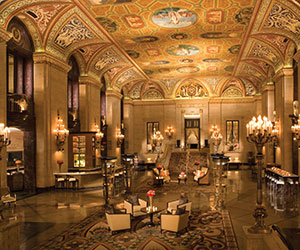 |
Palmer House® a Hilton Hotel (1871) Chicago, Illinois A visit to see the art collection at the Palmer House is almost an extension of the Art institute of Chicago. In 1922, the Art Institute of Chicago acquired much of the collection of Bertha Palmer and her husband, Potter Palmer. The core of their collection was their Impressionist paintings, which included works by artists such as Claude Monet, Pierre-Auguste Renoir, Camille Pissarro, and Edgar Degas. Many of these paintings are now among the highlights of the museum’s permanent collection. When the Palmers began collecting Impressionist art in the 1890s, it was considered radical, even controversial. It is due to Mrs. Palmer’s forward thinking, influence, and willingness to pursue her own taste rather than follow trends that Chicago is home to one of the greatest collections of Impressionism in the world. Bertha Palmer died in Florida on May 5, 1918, and in her will, she made two bequests to the Art Institute valued at $100,000 and $400,000. These funds were to be used to purchase works of art from her collection. The pieces were chosen and evaluated by the museum’s trustees, including her sons, Honoré Palmer and Potter Palmer, Jr. Her sons supplemented the bequest with a donation of thirty-two additional paintings and pastels. In 1922, the Palmer collection was installed in galleries 25 and 26, which is present-day galleries 206 and 207, respectively, in the museum’s Allerton Building. These paintings have constituted the core of the Art Institute’s Impressionist holdings ever since. |
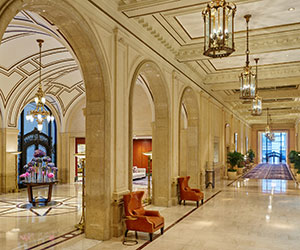 |
Palace Hotel (1875) Entering this landmark historic hotel’s stunning Garden Court and its marble columns, massive chandeliers, and majestic atrium crowned with more than 80,000 panes of stained glass will take one’s breath away. Then cozy up to the swanky Pied Piper Bar, where visitors can sip a cocktail or dine on American cuisine under The Pied Piper of Hamelin, one of only two Maxfield Parrish barroom artworks in the country. Commissioned in the aftermath of the 1906 Great Earthquake and Fire, the legendary 16-foot-long painting made its debut with the hotel's grand reopening in 1909 and has enjoyed its comfortable home ever since. |
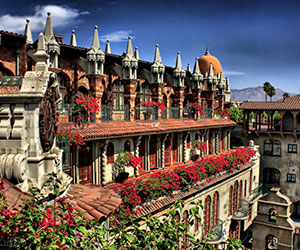 |
The Mission Inn Hotel & Spa (1876) The Spanish Art Gallery is located on the lobby level of the hotel and may be accessed through the first floor Atrio Court. Richly appointed, the Spanish Art Gallery’s regal 17th century Eruopean décor in a warm palette of gold offers the ultimate in sophistication and exclusivity. The venue features a grand marble staircase with wrought iron and a ceiling richly draped in gilded canopy ambiance bathing the room in pure extravagance. Dining and dancing under the exquisite art collection makes for an unforgettable event that is nothing short of magical. The Spanish Art Gallery can accommodate up to 150 guests for private events. |
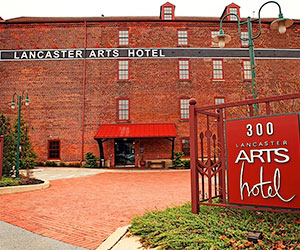 |
Lancaster Arts Hotel (1882) Lancaster Arts Hotel serves as one of Lancaster, PA’s premiere art galleries, displaying over $300,000 worth of fine art throughout its historic walls. The gallery exposes the work of established artists to a broader audience and promotes the rich fabric of the arts in Lancaster County. Boasting a mixture of paintings and sculptures and a combination of 16 local artists on display throughout the hotel at any given time, the hotel has already featured 32 artists since its opening in 2006. See a great piece? Many are available for sale based on artist discretion. While tours are not given, artwork is displayed throughout the hotel and guests are welcome to view the paintings any time. the Landcaster Arts Hotel main gallery is open daily for guests to visit, and also serves as a unique space for functions and events. |
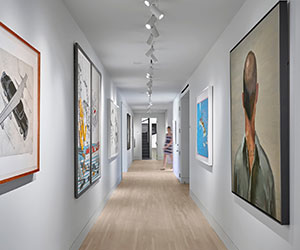 |
21c Museum Hotel Kansas City by MGallery (1888) Currently on view at 21c Museum Hotel Kansas City by MGallery is OFF-SPRING: New Generations. Rituals – religious and cultural, institutional and domestic – provide the thematic infrastructure for OFF-SPRING: New Generations. These sculptures, paintings, photographs, and videos employ iconographic imagery to explore the development of both personal and group identity, childhood, family, history, and gender politics. New and old narratives of at home, at the wedding altar, or in the classroom, within the fantasy of childhood play, or the familiarity of grown-up habit, all generate a spectrum of meditations on the contemporary construction of self and society. The exhibition includes over 80 works of painting, sculpture, photography, and video by 44 artists from 21 countries. While entering the building, guests are greeted by Lufterk’s Linear Sky; an immersive light installation that leads people inside the historic hotel. Light fixtures vary in length, producing an anamorphic optical illusion of an expanding, outward pattern of line and color. The LEDs are programmed with a lighting sequence inspired by the changing hues of the outdoor skies above the urban landscape of Kansas City and while the palette of bright morning saturates the walls that greet visitors, the glow of waning daylight colors envelop those headed outdoors. As guests enter the dome gallery, they encounter Ken and Julia Yonetani’s Crystal Palace: The Great Exhibition of the Works of Industry of all Nuclear Nations (U.S.A.): a massive chandelier comprised of glowing uranium glass. Part of a larger body of work looking at the nuclear capacity of all the nuclear nations, the size of each chandelier relates to the scale of each country’s nuclear power capacity. Beneath the historic Tiffany glass dome in 21c Museum Hotel Kansas City by MGallery, this work references nature, artifice, technology, and various manifestations of power, expressing the artists’ interrogation, “In the future, what should we wish for?” The Savoy, the restaurant and lounge at 21c Museum Hotel Kansas City by MGallery, highlights the building’s historical elements while bringing new life and energy to the space known for its famous patrons, including Harry Truman, Theodore Roosevelt, William Taft, and John D. Rockefeller. Within this historic space, Brad Kahlhamer’s sculptural installation Super Catcher, Vast Array, takes the form of multiple Native American dream catchers, made of wire and bells. Working at a large-scale to create intricate, wire and bell sculptures that shimmer and cast shadows as the light passes over and through the space, Kahlhamer subverts commercial association. His work affirms the magical, mythical spirit of the dreamcatcher expanding its power. Super Catcher, Vast Array is a superhero—delicate yet strong, heavy with history yet light with new hopes and dreams. |
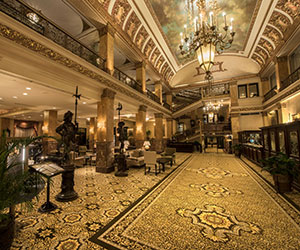 |
The Pfister Hotel (1893) Collected by Guido and Charles Pfister, the historic hotel houses the largest Victorian art collection of any hotel in the world. Visitors can explore and learn about this art collection with a self-guided tour or a scheduled tour with the hotel’s current Artist-in-Residence. As guests enter, they are greeted by the two bronze statues called the Pikemen dating back to the opening of the hotel, standing on each side of the entrance. Moving through the hotel, nearly all of the work embraces a style that was very much in vogue in the early 1900’s and seems so natural and appropriate today hanging on the walls of a hotel conceived during a bygone era. The landscapes, portraits, and sculptures are distributed throughout the hotel and serve as a welcome invitation at the top of each stairway or down a long corridor. |
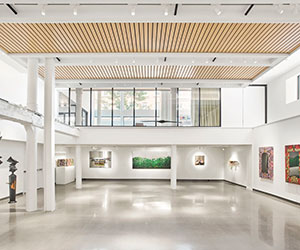 |
21c Museum Hotel Nashville by MGallery (1900) Currently on view at 21c Museum Hotel Nashville by MGallery is Fragile Figures: Beings and Time, which illuminates the range and complexity of human emotions, revealing intersections between vulnerability and power—social, cultural, and political—in contemporary portraiture. Individual and group identity, and the forces that shape how we see self and other, are approached through direct references to noted works from art history, connecting past events to current issues. The exhibition includes over 111 works of painting, sculpture, photography, and video by 55 artists from 18 countries. As visitors walk towards the public restrooms off the lobby, they will see a central screen located at the end of the corridor. This is Rafael Lozano-Hemmer’s Bilateral Time Slicer Intermix, a biometric tracking system that finds the axis of symmetry of visitors using face detection. When the axis is found to be in an almost vertical orientation, the computer splits the live camera image into two slices. With each new participant, time slices are recorded and pushed aside. When no one is viewing the work, the slices close and rejoin creating a procession of past recordings. Paying homage to the building’s past life as the Gray & Dudley Hardware Company, the re-imagined restaurant and lounge space embraces and celebrates high and low, new and old. Inside of the restaurant, Beth Cavener’s ceramic sculptures combine human and animal traits in both form and subject matter. The multi-hued figures in Cavener’s Emotions series are named for the four “humours,” the Greco-Roman theory that physical health and personality are determined by the relative balance of bodily fluids: the blood red The Sanguine is wound tight with energy, poised for activity, The Melancholic is pale, weighed down in thought or sorrow, the yellow The Choleric is posed in motion, expressing a youthful energy, hung from its hips and looking impassively outward, The Phlegmatic’s pale blue features suggest the winter of age. In each, the intricate details of facial features, bodily form, color, and the lines delineating fur, muscle, and bone express and elicit a range of human emotions and experiences. |
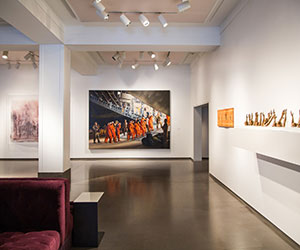 |
21c Museum Hotel Cincinnati by MGallery (1912) Currently on view at 21c Museum Hotel Cincinnati by MGallery is Dress Up, Speak Up: Regalia and Resistance. Bedecked and bejeweled, the figures populating Dress Up, Speak Up: Regalia and Resistance occupy fluid space and time, evoking past and present, fact and fiction, memory and desire, to illuminate the complexity of contemporary identity. The exhibit includes 69 works of sculpture, painting, works on paper, and a site-specific installation from 36 artists representing 19 different countries. Brian Knep’s Healing Tiles uses custom software algorithms to create a glowing pool of organic patterns on the lobby hallway floor at 21c Museum Hotel Cincinnati by MGallery. Left alone, the patterns slowly pulsate and shift over the course of each day. When visitors walk across the piece the patterns tear apart and rebuild themselves, but never exactly as before. Uros, a light sculpture by interdisciplinary artist Grimanesa Amorós, was originally designed to be a floor installation, but the artist adapted Uros to be installed as a wall sculpture at 21c Museum Hotel Cincinnati by MGallery. A custom-designed lighting sequence changes the color of the piece to emit a spectrum of glowing hues, transforming the surrounding space, and engaging viewers in an awareness of site and self, while referencing the Peruvian island environment of Uros. The shimmering, shifting spectrum of color emanating from the nine-story interior solarium is Astrid Krogh’s Lightmail; a three-part fiber optic tapestry woven on a loom in the artist’s Copenhagen studio. A trip to the 21c Museum Hotel Cincinnati by MGallery spa transforms into a spatial and kinetic experience by artist Ryan Wolfe. Wolfe’s Field of Grass, which spreads across the stairway wall up to the spa, distills and recreates the feel of a windswept, grassy expanse. The movement of the blades is activated by wind data and viewers can watch as a gust of air moves across the entire installation. Metropole on Walnut, the restaurant at 21c Museum Hotel Cincinnati by MGallery, features Drew Hetzler’s Queen City of the West, a map of connectivity centering on the city of Cincinnati as a series of images that together become a portrait of the city’s history and culture. Symbols, snapshots, and designs from many points in the city’s social history combine or collide. In a single glance, one may view the emblem of the Society of Cincinnati, a portrait of Lucias Quintas Cincinnatus, an antique Ivory Soap package, and a photograph of the Cincinnati Reds as 1919 National League Champions. Adjacent to the Walnut Street entrance is Austrian artist Werner Reiterer’s enormous, ornate, brass chandelier, which illuminates and animates the surrounding streetscape. Hanging from the straight right angle of its clean, white scaffold, Reiterer’s sculptural confection recalls the chandeliers that adorned old-world ballrooms hundreds of years ago—now installed on a 21st century street corner. Reiterer’s chandelier engages viewers inside as well: when visitors press a bell in the reception lobby, the sculpture’s audio component is activated, and the sound of breathing—distinctively human breathing—emanates from the chandelier’s speakers. A light sensor on the chandelier determines the auditory quality of the breathing: during the day, the sound is that of air inhaled; at night, breath being released, and the chandelier’s lights flicker on and off. The exhibition currently on view includes four works by Jeffrey Gibson, an artist of Cherokee and Choctaw heritage. Gibson explores the material histories and futures of several Indigenous handcraft techniques and aesthetics, including Southeastern river cane basket weaving, Algonquian birch bark biting, and porcupine quillwork. The helmet sculptures included were created for a 2019 exhibition at New York’s New Museum, entitled The Anthropophagic Effect. On the side exterior wall of 21c Museum Hotel Cincinnati by MGallery features a 10’ x 80’ mural, Vibrant Minds Colorful Lines, painted by KIIK Create and Jenny Ustick. Created in 2017, this work activates the site’s brick alley, a well-traversed route of downtown pedestrians. |
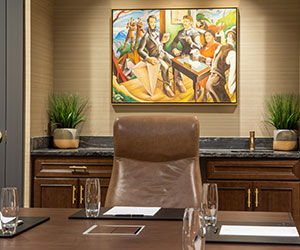 |
The Virginian Lynchburg, Curio Collection by Hilton (1913) Commissioned specifically for the hotel after a renovation in the 21st century, Kevin Chadwick’s paintings in the lobby are the perfect complement to the unique history of the historic hotel. In homage to the building’s art deco architecture, the four paintings mimic the 20’s style while featuring Lynchburg residents of note. The 16 feet of paintings incorporate the same palette as the hotel’s interior. Elsewhere in The Virginian, guests can spot art for sale in a rotating gallery and unique caricature style portraits of famous folk with ties to Virginia including Edgar Allan Poe and Ella Fitzgerald. |
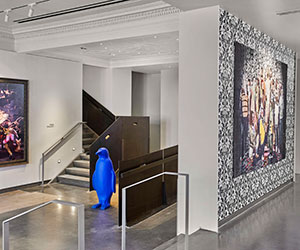 |
21c Museum Hotel Lexington by MGallery (1914) Currently on view at 21c Museum Hotel Lexington by MGallery is Pop Stars! Popular Culture and Contemporary Art. Superheroes and celebrities, totems and toys, the imagery of manufactured fantasy is reframed in the visual language of historical iconography in this multi-media exploration of popular culture nearly two decades into the 21st century. Appropriating images and practices from commerce, science, politics, religion, sports and technology, these artists illuminate recent shifts in how culture is being created and consumed. Pop Stars! features 80 works by 45 artists from 13 countries. Inspired by the ordered asymmetry of crystals, New York design studio SOFTLab has transformed the entry of the 1914 Fayette National Bank into an immersive installation that looks different from every angle. By cladding the complex aluminum structure with 3M dichroic acrylic, the piece changes color and reflectivity as visitors move around it. Varying in color and lit from within, the acrylic spheres hanging overhead in Lockbox, the restaurant at 21c Museum Hotel Lexington by MGallery, are arranged as atmospheric molecules in Bigert & Bergstrom’s multi-media installation, Tomorrow’s Weather. The atmospheric molecules (H2O, C2, N2, etc.) change color depending on the following day’s weather forecast. The work updates three times a day in accordance with the latest weather service reports, changing its guise accordingly. In Lockbox’s private dining room, formally the Fayette National Bank’s vault, Lyons and Wilson’s contemporary ceramic tile installations reference aspects of cultural antiquity while addressing current social, economic, and political issues. Featuring images of bullet casings, BRASS is one of several works in the Unswept Floors series, which is an investigation of current material culture reflecting back on an ancient Roman home decorating trend of commissioning mosaics of images of fallen food scraps from extravagant dinner parties. Outside the room, guests are greeted by Totally in Love, two intertwined lampposts; their supple, arched lines and blown glass bulbs transforming industrial urban design into playful, organic form. Dutch artist Pieke Bergmans originally conceived these lamppost lovers for an exhibition in Italy entitled Metamorphosis. This metamorphosis is an anthropomorphic one, turning streetlights into a couple Totally in Love. The exterior of the building currently features two artworks. Ebony G. Patterson’s I AM A PROMISE, from the series ‘…when they grow up.” The brightly colored vinyl work pictures a young Black child, innocent and full of promise. The title refers to a children’s hymn, but the artist asks, “What happens when the society doesn’t see you as a promise, as a gift, as someone that has all of this potential to be cared for? What happens when society doesn’t see you only as a promise but rather as menace and threat? What happens to a promise that is unrealized?” On the rear of the building, Jessica Sabogal’s mural Daughter of Immigrants, a larger-than-life, close-up view of a young child, recognizes the artist’s place as a first-generation, Colombian American immigrant. Sabogal dedicates this work to “…the in-betweens: the ones that know the split between here and there, the ones that exist in both and neither on, all at the same time. This is for my parents who escaped, who made it out – I always wonder if they feel it was work it. This is for the daughters that work with the weight of another country on their backs.” |
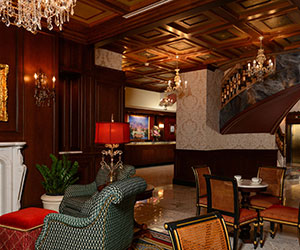 |
The Broadmoor (1918) American West art influences The Broadmoor, boasting a large part of the Anschutz collection. These paintings of the Wild West range in subject from hunts, first nation’s peoples, and cowboys. Astute guests will notice rooms named for artists, such as the Remington room. Named after the Yale-educated New Yorker Frederic Remington, one of the greatest western painters, sculptors, and illustrators of his time, cowboy Frederic Remington captures the spirit of the American West like a wrangler roping a runaway calf while on horseback. To take some art home, guests can visit the Broadmoor Galleries. Located onsite of the AAA Five-Diamond resort are the Broadmoor Galleries, representing emerging and established regional, national, and international artists in a cross section of genres, styles, and mediums including painting, works on paper, mixed media, photography, and sculpture. |
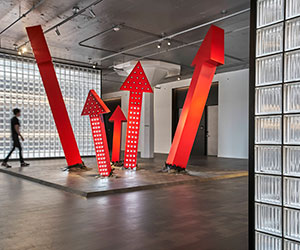 |
21c Museum Hotel Oklahoma City by MGallery (1916) Currently on view at 21c Oklahoma City is Seeing Now Seeing Now’s multi-media selection of artworks. These pieces explore what and how we see today; revealing the visible and hidden forces shaping what the contemporary world looks like, how we consume and interpret that information, and how visual and psychological perception are evolving in the 21st century. Featured artists interrogate power, both hidden and overt, in the gulf of what is seen and known between appearance and reality. The exhibition features 74 works of painting, sculpture, photography, and video by 38 artists from 19 countries. Embedded across the ballroom floor at 21c Oklahoma City is Stockholm-based artist Gunilla Klingberg’s Spinning Wheel of Life, a site-specific artwork that engages both the origins of the site, and the transformation of the Ford Motor Assembly Plant from an industrial factory into a contemporary, multi-use cultural center. Inspired by this history, Spinning Wheel of Life consists of ubiquitous urban signage and symbols in cut-out metal that are incorporated into the floor and repeated in a kaleidoscopic pattern, resembling a cosmological chart and a mandala image. Guests and visitors to the three upper floors at 21c Oklahoma City will be greeted by an installation of six-, nine-, and twelve-foot red arrows pointing in every direction and pulsating with a dynamic lighting sequence. This site-specific installation does not provide directional guidance, but instead creates a heightened awareness of the surrounding space while referencing a range of ideas and imagery. As guests walk through the front door of Mary Eddy’s, the restaurant at 21c Oklahoma City, they are greeted by a new kind of conveyor belt, James Clar’s River of Time. The tops have been replaced with semi-transparent sheets of acrylic, creating moving panels that flow like an animated river up and over a waterfall that is also a large clock with the current time. Jarica Walsh, an Oklahoma City-based artist and a member of the Osage Nation, has a solo show on view currently. Her exhibition, Collective Growth, brings together a variety of botanical cyanotypes made from plants and leaves found in private “corona gardens” on the grounds of the future First Americans Museum and around her Oklahoma City neighborhood during the COVID-19 pandemic in 2020. Outside, find Woozy Blossom, a sixteen-foot tall, perforated steel tree that produces intermittent mist during the sizzling summer months, engulfing visitors and passersby in its spray and allowing them to revel in its cool, moist air. The fog is in a constant state of flux, sensitive to the slightest change in wind, temperature, and humidity. Simultaneously eerie, unexpected, and playful, Woozy Blossom transforms the urban exterior of 21c Oklahoma City into an ever-changing, otherworldly environment. The work, which offers a seductive invitation to interact, both complements and disrupts its surroundings. A tree among trees, its industrial materials and mechanics provide material reference to the history of this former factory site. On rainy days when visitors might more likely view the sidewalk than look above, a poem by local group Short Order Poems, created out of waterproof paint and hand-cut stencils, becomes visible on the sidewalk. Otherwise undetectable, the poem’s appearance each rainy day is a reminder of art’s resilient power. |
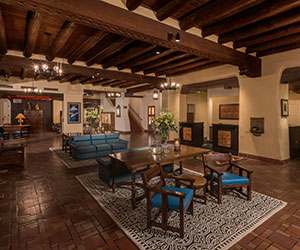 |
La Fonda on the Plaza (1922) The wholly owned art collection of La Fonda on the Plaza began at the hotel’s inception and has grown considerably over the years. Paintings by the best Pueblo artists were acquired in the historic hotel’s early years, and Sam and Ethel Ballen carried on that tradition followed by Jenny Kimball, all supporting Santa Fe’s famed Indian Market and acquiring work by Native Americans and other artists for the hotel. Not only does original art hang in every guestroom, but every piece has a connection to the people who designed, built, and owned the hotel—a collaboration that has garnered La Fonda a reputation as one of the best Santa Fe hotels and a sought-after destination for more than 90 years. |
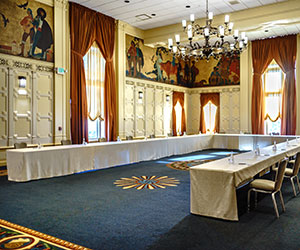 |
InterContinental Mark Hopkins San Francisco (1926) When searching for an incredible art collection at this San Francisco landmark, guests need to look no further than the Room of the Dons. Maynard Dixon and Frank Van Sloun, two of California’s most famous Western artists, created the works for the historic hotel’s grand opening on December 3, 1926. The nine murals portray the history of early California in a rich medley of reds, blues, and browns against a background of gold leaf. Each mural is seven feet tall and show its own slice of Californian history:
When the Mark Hopkins opened in 1926 to great fanfare, Maynard Dixon and Frank Van Sloun's murals were an instant sensation. The Room of the Dons and its paintings continue to delight the generations of San Franciscans and guests at the InterContinental Mark Hopkins |
 |
21c Museum Hotel Chicago by MGallery (1927) Currently on view at 21c Chicago is This We Believe. This We Believe explores the power and evolution of belief systems—religious, political, economic—and how adherence to and rejection of these ideologies has influenced our current global culture of divisiveness and polarization. From the imagery of disillusionment and protest, to revelations of historical complexity, to visions of transcending binary definitions of identity, the artworks featured question and critique unalloyed allegiance to creed or country. The exhibition includes over 110 works of painting, sculpture, photography, and video by 57 artists from 28 countries. Specially commissioned site-specific Wallworks by Chicago-based, internationally recognized artists, Nick Cave and Bob Faust, transform the elevator lobbies of the 21c Chicago building. Cave and Faust conceived of each landing as part of a portal system to define and make memorable each embarkation and debarkation. Installed in elevator lobbies on floors 2 thru 7, each is a diptych of two complimentary patterns, designed from individual detail photos from Cave's iconic Soundsuits and Tondos. Each photo was chosen for formal reasons, such as color and composition, and also to showcase the variety of materials Cave uses throughout his work such as synthetic hair, sequined fabric, buttons, wire, and vintage toile. The patterns themselves are designed to convey the performative aspects of Cave’s practice which are difficult to capture in still photography. |
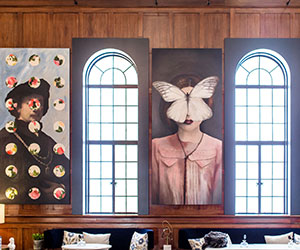 |
The Heathman Hotel (1927) The Heathman Hotel has an extensive art collection, which includes an array of paintings, photographs, and works on paper by a multitude of artists. Among the best in the collection are prints from Andy Warhol’s Endangered Species lithograph series. |
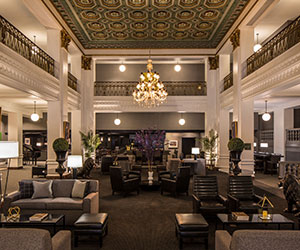 |
Lord Baltimore Hotel (1928) Tucked into the middle of Baltimore, sits one of the largest private contemporary art collections in North America. At this museum, guests can even stay the night. The vast collection displayed throughout the hotel was curated by Mera and Don Rubell of The Rubell Family Collection and the Rubell Museum. Art has been the Rubell's’ passion since their first acquisition in 1965. Since then, they have built one of the most significant and far-ranging collections of contemporary art in the world, now encompassing 7,200 works by more than 1,000 artists – and still growing. The collection is further distinguished by the diversity and geographic distribution of artists represented within it as well as the depth of its holdings of seminal artists. In 1993, their passion became their mission with the opening of the Rubell Family Collection/Contemporary Art Foundation in the Wynwood neighborhood of Miami, which pioneered a new model for sharing private collections with the public and spurred the development of the neighborhood as one of the leading art and design districts in the U.S. Walking through the “LB” as its affectionately known, guests discover a wide variety of art. Throughout the lobby and the mezzanine floor is abstract painting by Herbert Hamak, the hallways are lined with a series inspired by Google Images and iconic people and places linked to Baltimore. Google Inspired Portraits of Famous Baltimore People and Places, 2013 includes fifteen unique prints in an edition of 1500 from the Rubell Family Collection Design Team. A Suzan Etkin multimedia piece is on display in the hotel’s fitness center and the guestrooms feature both contemporary and historic: two pieces of artwork by painter Sabrina Baron, Mera Rubell’s sister and a print of a historic rendering of the Lord Baltimore Hotel from 1928 by an unknown artist. In 2018, the hotel launched a quarterly art exhibition series called In Good Taste at its LB Bakery featuring a local artist’s work. To-date, the hotel has hosted seven exhibitions as part of this series that provides an opportunity for the hotel to celebrate the works of local artists. At the conclusion of each exhibition in the bakery, the artwork is moved to go on display for a limited time in the hotel’s Artist Crown Suite. The hotel then purchases one piece from each collection to go in the hotel’s permanent The Tribute to Good Taste Exhibition. |
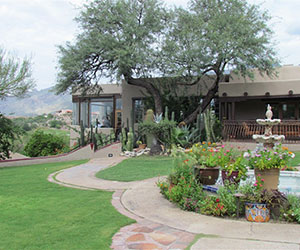 |
Hacienda del Sol (1929) Surrounded by the stunning Santa Catalina Mountain Range, Hacienda Del Sol Guest Ranch Resort adds man-made visual and intellectual stimulation with a beautiful collection of art throughout the grounds. The collection, curated by Resort Partner and Director of Gardening & Art Jeff Timan and his wife and Gift Shop Manager Robyn Kessler, features artists including Rigsby Frederick, Steven Derks and Carlos Carulo to name a few. Many pieces, recognizable by the medium of welded steel and an abstract nature – were created by Timan himself. Take a stroll through the property and enjoy over 100 pieces of artwork guests can find sprinkled throughout the 34-acre resort.
|
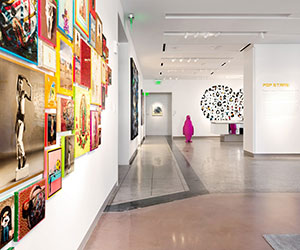 |
21c Museum Hotel Durham by Gallery (1937) Visitors, tourists, and the public as well as hotel and restaurant guests are greeted by Vik Muniz’s Diaspora Cloud flag flying on 21c Museum Hotel Durham by Gallery’s historic flagpole before entering to explore the art within the building. Currently on view at 21c Museum Hotel Durham by Gallery is the The Future is Female. Investigating history, mythology, identity, ecology, consumerism, and power, The Future is Female illuminates both the legacy and the persistence of the struggle for equality and inclusion. The exhibit includes 96 works of sculpture, painting, works on paper, and a site-specific installation. There are 58 artists in this exhibition that hail from 12 different countries. At 21c Museum Hotel Durham by Gallery, Claire Shegog transforms miniature female figurines typically used as confectionary decorations into a range of characters that evoke various cultures, the southern belle, the cloaked Muslim, the ballroom dancer, painting each one by hand and affixing hats, jewels, and other accessories. She presents these tiny dancers on the horizontal surface of the reception desk. As visitors ascend physically on the elevator or the stairwell, Andrew Erdos’s Ascendance, which consists of waterjet cut mirror glass and a panoramic video loop that can be seen in cloud ‘windows’ cut into mirrors, surrounds them. A visit to restrooms on the mezzanine reveals signage by All is Fair in Love and Wear that proudly declares “Everyone All Ways.” When a guest enters 21c Museum Hotel Durham by Gallery’s restaurant, Counting House, they look up to view the Cincinnati, Ohio- based artists’ Katie Parker and Guy Michael Davis, known as FUTURE RETRIEVAL, eighteen chandeliers, grouped in six clusters, for the lounge. White porcelain busts of bear heads are adorned with porcelain collars. Yupo paper bunting cut into floral forms envelope the bear heads and link the chandeliers together and to the ceiling. Look down in the historic bank and spot the work of Leslie Lyons and JB Wilson, whose editioned porcelain tiles, BANK, from the series Unswept Floor, fills a portion of the floor in the lowest level of the 21c Museum Hotel Durham by Gallery building. Continue to explore the artwork in Counting House and learn, like the transformation of the historic building, recycling is synonymous with reinvention. Johnston Foster’s near life-size safety-barrel tiger, discarded-wood moose, and a zebra head assembled from a stripped leather couch and a broom brush, Yong-Ho Ji’s twin-headed tire ram, a rhino head comprised of gold-tipped matches by David Mach: the realism of today’s “trophy heads” resides in materiality. Rather than celebrate the power of humans over animals, these sculptures attest to the proliferation of commercial and industrial products, recycled, and transformed. Decommissioning a commercial product, Duke Riley explores past, present, and future in It Will Warm You Twice. The cigarettes and mini cigars Riley utilized to create this large-scale mosaic reference the ubiquitous role that tobacco has played in the development and history of Durham, as well as the decline of its influence. |
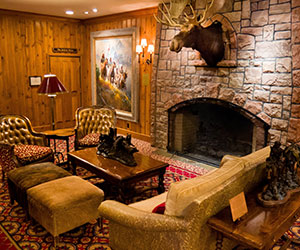 |
The Wort Hotel (1941) The Wort Hotel is a must stop for the Western Fine Art Enthusiast. The Hotel contains over 175 pieces of original contemporary and traditional Western Art, valued at over $1.2 million. Each piece of art was carefully chosen by Wort owner Bill Baxter and represents his passion and style for art. It features sculptured bronze work, acrylics, and oils. Something more unique in the art world is the Hand Carved Wood Western Themed Doors. Each door represents a theme for the Suite décor inside: Cowboy, Cowgirl, Shoshone, Teton, or Silver Dollar. Look inside these rooms and guests will find additional original artworks from that region or time period. The Silver Dollar Bar is known for its Saloon pieces by recently deceased artist Ray McCarty. He was known as a Renegade in the art world with his art inspired by his outlaw heritage and connection with Butch Cassidy’s McCarty gang. The Wort Hotel and Silver Dollar Inc. have the largest collection of McCarty pieces at 50; Steven Wynn of Las Vegas has 42 making his the 2nd largest collection. The Shoshone Suite as well as some of the public spaces of the hotel feature Native American pieces conveying historical depictions of the Western Frontier and Native American Tribes, and include key pieces by Gerry Metz, John Clymer and Joe Velazquez are included. Velazquez pursued his creative passion in fine art portraying with historical accuracy the people and routes of the fur trade era. The hotel features a free self-guided walking tour brochure with photos and descriptions of key pieces of art in this privately owned collection. |
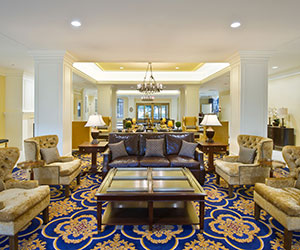 |
Morris Inn at Notre Dame (1952) The Morris Inn is in the heart of campus at the University of Notre Dame. Once guests have checked in, they will receive a complimentary walking map tour of 21 sculptures that dot campus. These sculptures are the work of Croatian sculptor Ivan Mestrovic. Born in 1883 to peasant farmers, Mestrovic studied art, sculpture, and the stories of the Bible throughout his life, receiving high praise from well-respected leaders throughout Europe and America. Mestrovic was brought to the University of Notre Dame by Rev. Theodore M. Hesburgh, CSC, in 1955 with help from Rev. Anthony J. Lauck, CSC, founding director of the Snite Museum of Art, chair of the art department, and a sculptor himself. Mestrovic also sculpted and taught on campus for seven years until his death in 1962. Wondering where to start? Discover the Marko Marulic (1925) Portrait of the 15th-16th century Croatian poet and humanist, located on the Wind Family Fireside Terrace. Many believe Mestrovic used his own likeness to depict Marulic’s face. Ivan Mestrovic was an artist and professor on campus. |
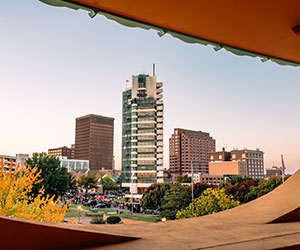 |
The Inn at Price Tower (1956) Discover the imposing 19-story façade of Price Tower, Frank Lloyd Wright’s only skyscraper, and the Inn at Price Tower, which occupies seven of the tower’s upper floors. This U.S. National Historic Landmark, which Wright called The Tree That Escaped the Crowded Forest, features cantilevered and copper patina floors that extend like tree branches from the trunk of the tree, which consists of four quadrants, each with its own elevator shaft. Within the UNESCO World Heritage Nominee are exhibitions and collections of the Arts Center, which boasts renderings, architectural fragments, and archival materials. |
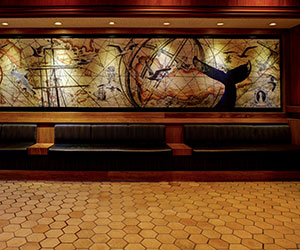 |
Hotel Captain Cook (1965) Upon arrival at the Hotel Captain Cook, guests and patrons alike are greeted by inviting and historical décor illustrating the voyages of British explorer and cartographer Captain James Cook. Three of these major voyages took him around the southern tips of Africa and South America, to Easter Island and, on his final voyage, along Alaska’s majestic coastline. In June of 1778, while looking for a northwest passage to Hudson Bay, he and his crew on the HMS Resolution dropped anchor in Turnagain Arm, right within sight of the spot where the Hotel Captain Cook stands today. A much sought-after experience for both the art enthusiast and the novice art lover, the Hotel Captain Cook offers walking tours of their expansive private art collection. Featuring paintings, drawings, and sculptures of subjects like historical sailing ships, Indigenous people and depictions of the Captain’s excursions, guests will marvel at the adventures of Captain James Cook through the lens of a time long ago. In addition to the hotel’s architecture itself, unique art pieces like stained glass, paintings, woodwork, and sculpture continue to tell this story with inspired detail. Pieces of the collection can be viewed in common areas and are also prominently featured in well-appointed dining spaces, lining pristine hallways and in other perceptible instances throughout the hotel. |
 |
Mauna Kea Beach Hotel (1965) In the early 1960’s Mauna Kea Beach Hotel’s developer, Laurance S. Rockefeller, envisioned the hotel as a “private estate offering a cross-cultural experience.” Today, hundreds of museum-worthy pieces from the priceless collection are displayed throughout the hotel. Highlights include an enormous 12th century pink granite Buddha from India that is reposed beneath a Bodhi (enlightenment) tree at the summit of the hotel’s grand stairway, two gold-gilded prayer disciples that flank the lobby entry and welcome guests, and Hawaii’s largest standing collection of Hawaiian quilts, each made especially for Mauna Kea Beach Hotel. There are also Maori canoe prows, bronze Indian dowry chests and New Guinea shields among many other numerous pieces. A recent partnership with Honolulu’s famed Bishop Museum has brought about stabilization and enhanced displays of the hotel’s treasured collection of traditional Hawaiian kapa (pounded bark) cloth. The Mauna Kea Beach Hotel art collection was the first of its kind ever assembled for a hotel anywhere in the world. Honoring Rockefeller’s vision, the pieces are still displayed in a manner that encourages self-discovery. Visitors wishing to learn more are welcomed to join a complimentary art tour each Saturday morning. On the hotel’s website, links to a half dozen podcasts allow visitors to delve even more deeply into the collection’s history and its pieces. |
Read all our Top 25 lists:
Top 25 Most Haunted Historic Hotels
Top 25 Most Magnificent Gingerbread Displays
Top 25 Historic Hotels for a Romantic Proposal
Top 25 Most Magnificent Gardens
Top 25 Most Magnificent Ceilings and Domes






















